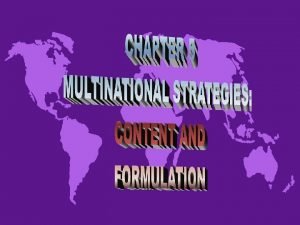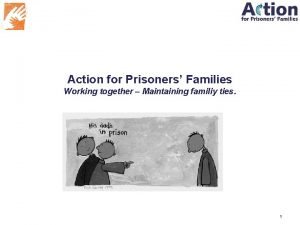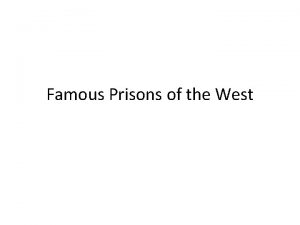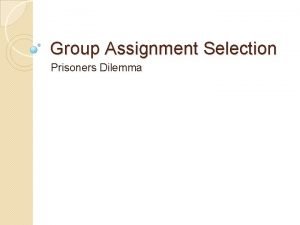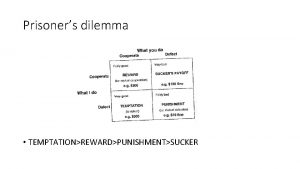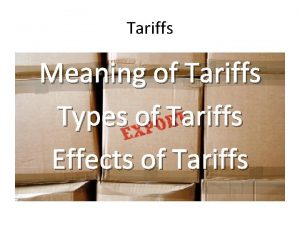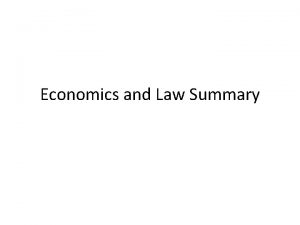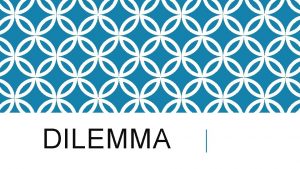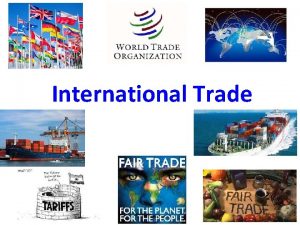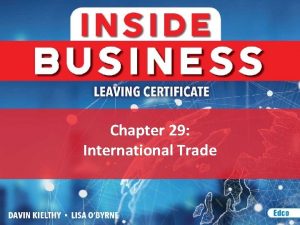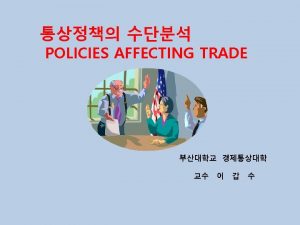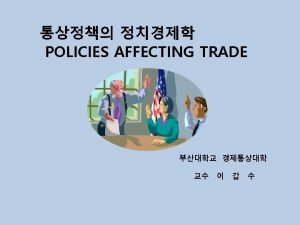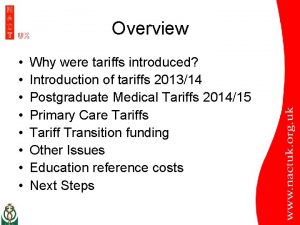The prisoners dilemma and international trade Tariffs and













- Slides: 13

The prisoners’ dilemma and international trade: Tariffs and the potential for trade wars

price The effects of a tariff: Pre-tariff (free trade) situation for a country S pw D imports Qf Cf quantity

price Partial equilibrium analysis of the impact of a tariff; home country is small and has no influence on world prices: Price rises to Pw+t; A + C are S net welfare losses Tariffs mean net losses for Small countries Pw+t pw E A B C D imports Qf Qt Ct Cf quantity

Optimal tariffs; home country is large and world prices fall to Pwn with the tariff (domestic price does not fall). Leads to a gain represented by H. Net gains for the country S are H – (A + C) price Pw+t pw Large countries can gain from trade restrictions like tariffs – but not if there is retaliation implying a trade war E A B C H New Pwn Qf import s Qt D Ct Cf quantity

3 possible scenarios 2 large countries n 2 small countries n 1 large country and 1 small country n ¨ Countries unilaterally decide whether or not to impose a tariff ¨ If both countries impose a tariff this means there is a trade war (retaliation) n In which scenario is there more likely to be a trade war? ¨ Analyse using game theory

International trade 1: both countries relatively large i. e. can affect own terms of trade Rosatia Jesmania no tariff impose tariff no tariff 10, 10 -1, 15 impose tariff 15, -1 2, 2 • Payoffs represent the value of net gains in €billions • Interpret the payoffs • What is the equilibrium of this trading game?

International trade 1 Rosatia no tariff Jesmania no tariff 10, 10 impose tariff -1, 15 impose tariff 15, -1 2, 2 • The dominant strategy equilibrium is for both countries to impose the tariff even though they would both be better off if neither imposed a tariff: • the countries are playing a prisoners’ dilemma

International trade 2: both countries relatively small Little Rosatia Little Jesmania no tariff impose tariff 10, 10 -1, 8 8, -1 -2, -2 • Payoffs represent the value of net gains in €billions • Interpret the payoffs • What is the equilibrium of this trading game?

International trade 2: both countries relatively small Little Rosatia no tariff Little Jesmania impose tariff no tariff impose tariff 10, 10 -1, 8 8, -1 -2, -2 The Nash equilibrium of this trading game is for neither country to impose a tariff

International trade 3: one large country one small country Little Rosatia Greater Jesmania no tariff impose tariff no tariff 10, 10 -1, 8 impose tariff 15, -1 2, -2 • Payoffs represent the value of net gains in €billions • Interpret the payoffs • What is the equilibrium of this trading game? ?

International trade 3: one large country one small country Little Rosatia Greater Jesmania no tariff impose tariff no tariff 10, 10 -1, 8 impose tariff 15, -1 2, -2 The Nash equilibrium of this trading game is for Little Rosatia not to impose the tariff but for Greater Jesmania to impose the tariff

Implications n Trade wars are more likely between large countries and large trading blocks ¨ like n the EU and NAFTA Small countries are unlikely to get involved in trade wars – more likely to gain from trade ¨ They stand to lose more than they gain by imposing tariffs since they are at the mercy of world markets n But small countries will lose out when large countries or trading blocks impose tariffs

Test your understanding n In the context of the economic analysis of tariffs, use game theory to explain why trade wars between large countries are more likely than trade wars between small countries.
 Prisoners dilemma
Prisoners dilemma Prisoners dilemma
Prisoners dilemma Prisoner's dilemma
Prisoner's dilemma What is global local dilemma
What is global local dilemma Prisoners dillemma
Prisoners dillemma When prisoners come home
When prisoners come home After they arrived the prisoners are supposed to shower
After they arrived the prisoners are supposed to shower Action for prisoners families
Action for prisoners families Folsom prison famous inmates
Folsom prison famous inmates Trade diversion and trade creation
Trade diversion and trade creation Trade diversion and trade creation
Trade diversion and trade creation Which is the most enduring free trade area in the world?
Which is the most enduring free trade area in the world? Trade diversion and trade creation
Trade diversion and trade creation Types of tramp chartering
Types of tramp chartering



